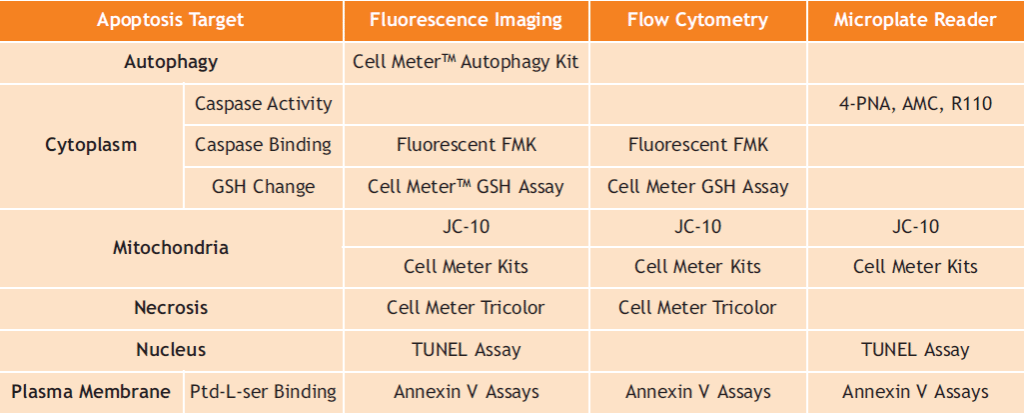Resisting Cell Death
In order to survive and proliferate, cancer cells must overcome and avoid the diverse range and number of cell death inducing signals. For over 10 years apoptosis as a mechanism of induced cell death has been well understood with advances now being made in our understanding of the other mechanisms of cell death – Autophagy and Necrosis, as barriers to cancer advancement.
Key Suppliers
- AAT Bioquest
- Biosensis
- Bioss
- Cell Technology
- Cusabio
- Dianova
- Jackson ImmunoResearch
- Selleck Chemicals
- Signosis
- Sino Biological
- Synvivo
Apoptosis
Tumour cells have evolved various strategies in an attempt to avoid apoptosis, the most common of which is the loss of TP53 tumour suppressor function. TP53 induces apoptosis in response to chromosomal abnormalities by upregulating expression of the Noxa and Puma BH3-only proteins. Loss of TP53 function removes this damage sensor and inhibits apoptosis, allowing cancer cells to survive and proliferate. Alternatively, tumours can increase expression of antiapoptotic regulators such as Bcl-2 & Bcl-xL, or of survival signals Igf1/2 by down regulating proapoptotic factors Bax, Bim and Puma.
Autophagy
Recent work has revealed relationships between the regulatory circuits governing autophagy, apoptosis and cellular homeostasis. The signalling pathway involving PI3, AKT and mTOR kinases is stimulated by survival to block apoptosis and also inhibits autophagy. However, when survival signals are not sufficient, the PI3K pathway is down regulated and as a result apoptosis and autophagy can be induced. (Hanahan, D. & Weinberg, R.A. 2010).
Necrosis
Necrotic cell death releases proinflammatory signals allowing recruitment of immune system inflammatory cells. These generally remove the associated cell debris, but in neoplasia there is evidence to suggest that they can promote angiogenesis, cancer cell proliferation and invasiveness. By tolerating some necrotic cell death, tumours may recruit tumourpromoting inflammatory cells and the related growth-stimulating factors, thereby assisting their proliferation.
Avoiding Immune
Destruction Current research suggests that highly immunogenic cancer cells may well disable immune system components sent to destroy them. Potentially, they may ‘paralyse’ infiltrating cytotoxic T lymphocytes and natural killer cells by secreting TGF-beta or other immuno-suppressive factors. (Yang et al. 2010; Shields et al. 2010) Other possibilities may include the recruitment of inflammatory cells that are actively immuno-suppressive, including regulatory T cells and myeloidderived suppressor cells.
We are proud to offer a comprehensive range of conjugated and unconjugated antibodies, clones, cDNAs, primer pairs, proteins and ELISAs to enhance and drive forward your work in this well researched cancer area.
For researchers looking at live cells and tissues, we have a number of kits and dyes to allow you to study cell death in the cytoplasm, mitochondria, plasma membrane and nucleus using various visualisation methods.

Fluorescent Probes
Recently developed ApoBriteTM U470 and V570 are the first fluorogenic probes for the direct detection of caspase activities in live cells, being more robust, convenient and accurate than existing live cell assays:
- Fluoresce without DNA interaction
- Do not inhibit caspase activity (as reported for FMK peptide probes)
- No cytotoxicity – do not bind covalently to caspases
- Low background
- Can be used in aqueous solutions
Compound Libraries
For the study of small molecule modulators, we offer an extensive range of inhibitors and activators in the form of libraries, or as individual compounds. Libraries include:
- Anti-cancer compounds
- Cambridge Cancer Compounds
- PI3K/AKT inhibitors
- MAPK Inhibitors
- Kinase Inhibitors
- Bioactive compound libraries
Key markers
To which we can offer products include:
- Caspase 8, 9
- BCL-2
- BCL-xL
- Mcl-1
- BH3
- TP53
- mTOR
- TGF-beta
- IGF-1
- PI3-kinase
& many more
References
- Hanahan, D. Weinberg, R.A. 2010. Hallmarks of Cancer: The Next Generation. Cell 144, 646-674.
- Shields, J.D. et al. 2010. Induction of lymphoid like stroma and immune escape by tumours that express chemokine CCl21. Science 328, 749-752.
- Yang, L. et al. 2010. TGF-beta and immune cells: an important regulatory axis in the tumour micro-environment and progression. Trends Immunol. 31, 220-227.